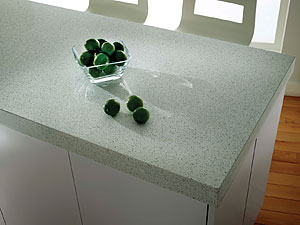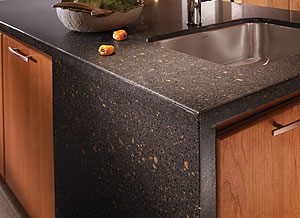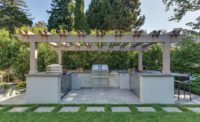
ECO by Cosentino is a new line of countertop and surfacing material composed of 75% recycled material.
What is ECO by Cosentino? What is it made from, and what are the environmental benefits of the material?
ECO by Cosentino is a revolutionary new line of countertop and surfacing material composed of 75% recycled material. The launch of ECO by Cosentino sets an unprecedented standard for the green building and sustainable design industries. The result of a $6 million research and development investment, this innovative new product caters to the environmentally conscious and design-oriented architect, designer and consumer by providing high performance, design and sustainability.
ECO by Cosentino is composed of 75% post-industrial and post-consumer recycled raw material, including mirrors salvaged from houses, buildings and factories; glass from windows and bottles; granulated glass from consumer recycling practices; porcelain from china, tiles, sinks, toilets and decorative elements; and industrial furnace residuals from factories in the form of crystallized ashes.

ECO by Cosentino is composed of 75% post-industrial
and post-consumer recycled raw material, including mirrors salvaged from
houses, building and factories; glass from windows and bottles; granulated
glass from consumer recycling practices; porcelain from china, tiles, sinks,
toilets and decorative elements; and industrial furnace residuals from
factories in the form of crystallized ashes.
• 60 million glass bottles
• 2 million standard size bathroom mirrors
• Approximately 540,000 square feet of ceramics
Reutilizing this significant amount of material prevents it from building up at landfills year after year, and reduces the need to mine for new resources. Moreover, for every square foot of ECO by Cosentino utilized, consumers are helping to save the same amount or more of natural resources.
How many colors are available?
At launch, ECO by Cosentino is available in two sophisticated color palettes - the Revive collection and the Green collection - totaling 10 individual designer colors, suitable for both commercial and residential projects. It is also available in both a polished and a matte Leather TextureTM finish.
What is the typical slab size?
ECO by Cosentino is available in jumbo slabs of 63 x 128 inches and standard tile sizes of 12 x 12, 18 x 18 and 24 x 24 inches. The jumbo slabs allow for a higher square footage of material per container, therefore minimizing the product’s carbon footprint, and they provide a higher yield of material during fabrication, minimizing seams and waste. The slabs are available in a 1.2-cm, 2-cm and 3-cm thickness to respond to varying market needs.
When fabricating ECO by Cosentino, what practical concerns are required when cutting the material? Do I need a specialized blade? Do I need to run my saw at a specific rpm?
When cutting on a saw, ECO by Cosentino can be cut with a regular diamond blade at 3,500 to 3,800 rpm. If cutting on a waterjet, fabricators can cut at the speed rate of 40 inches per minute.<

When cutting on a saw, ECO by Cosentino can be cut
with a regular diamond blade at 3,500 to 3,800 rpm. If cutting on a waterjet,
fabricators can cut at the speed rate of 40 inches per minute.
Cutting the material from the outside is best; however, plunge cutting is another option for fabricating, just like with quartz surfacing. Fabricators should plan for cuts to release tension prior to plunge cutting.
When working the edges of the material, do I need to work with special tooling or a specialized rate of speed?
Edge polishing should be treated the same as quartz surfacing.
Will the edge of the material match the surface once it is processed, or does additional finishing need to take place (as is the case with some resin-treated materials)?
Unlike concrete-based countertops, ECO is a non-porous surfacing material and does not require sealers. ECO by Cosentino matches the sophisticated look, feel and high performance of quartz composite surfaces and natural stone surfaces such as marble and granite.
Do the slabs have any problem with UV light, or can I store/install the material outside in direct sunlight?
ECO by Cosentino is recommended for indoor use only.
When installing countertops made with ECO by Cosentino, are there any major differences to consider as opposed to installing granite countertops?
We recommend strip decking rather than full decking when installing ECO by Cosentino. Also it should not be installed tight against the wall; a small gap of 1/8 inch should be consider for every 10-foot run.
How smooth is the finished edge once cut, as compared to the typical edge of cut granite? Do the edges at the seams need to be further treated or “roughed up” to make them work effectively with the seam adhesive?
Granite behaves differently - depending on the type of granite. ECO by Cosentino does not cut as cleanly as quartz surfacing. It behaves more like the most brittle granite. The type of blade, plenty of water and the speed of the blade are all key for a crisp cut. Nevertheless, ECO is not going to experience heavy chipping as it behaves much better than your typical cement-based, recycled glass material.
What types of adhesives seem to work best with ECO by Cosentino?
We recommend a polyester-based resin or an epoxy, although your typical solid surface acrylic-based glues also work well.
Do the seams at a cooktop or sink need to be rodded, as is typical with granite? Are there other special reinforcements needed?
ECO by Cosentino has a better flexural strength than granite. Therefore, it is not absolutely necessary to rod either cut-outs or seams, although it is always good practice to rod either.
